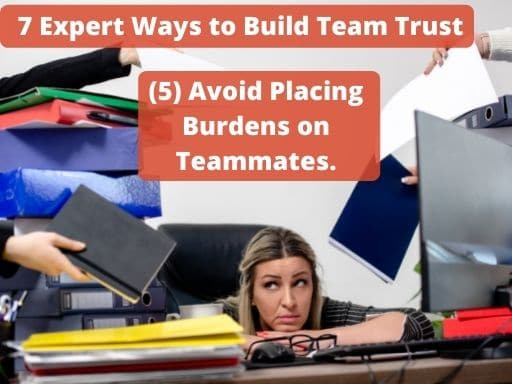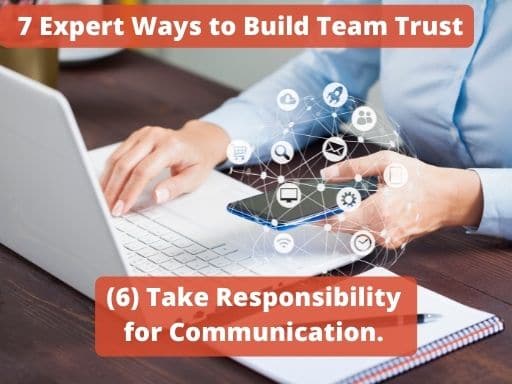Team Trust-7 Expert Ways to Build Trust in Your Team

In the first part, we gave an overview of each of the five steps to create a highly effective team. Then, last week, we covered the value of creating a great vision and mission for your company. Here is a review of this employee engagement process.
Five-Step Process to Build a Culture of Teamwork in Your Organization and Improve Team Success.
The five-step leadership development process is as follows.
- Highly Effective Teams are Mission-Oriented.
- Build Trust and Rapport with the People that You Want to Lead.
- Resolve Conflicts and Create an Environment Where Disagreements Do Not Cause Personal Conflicts.
- Gain Enthusiastic Cooperation from Your Team (Even When You Are Not Looking).
- Build Confident Leadership Teams Around You.
Each of these steps is progressive. For instance, if we have a lack of trust within a group of individuals, we will likely have more conflicts. If we are in conflict with our team members, it will be difficult to gain cooperation. The point is that the better we do in the early stages, the easier it is to have success in the latter stages. In this session, we will focus on Step #2: The Seven Best Ways to Build Team Trust.
How to Build a Culture of Trust in Your Team. 7 Expert Ways to Build Team Trust.
Think about the relationships that you have with others as being a checking account. Each person that you interact with has an entirely different account. When we have positive interactions with a person, we make deposits into that account and improve our level of trust with that person.
However, when something negative occurs or there is a conflict, a withdrawal is made. So, if you want to build trust in a team, you as the leader have to make a tremendous number of deposits into the accounts of each team member. However, if you make withdrawals, you and your team are likely to have trust issues.
Below are seven key ways to build mutual trust within a team. We suggest that you spend a week focusing on a single principle every day. Don’t go to bed each day before you apply the principle for that day. By the end of the week, you should already begin to see significant changes in the rapport that you have with others.
By using these principles consistently, you will create open communication and improve workplace trust.
- Avoid Criticizing Your Team.
- Look at Things from the Other Person’s Point of View.
- Smile More. (It Makes You More Approachable and Friendly.)
- Make an Effort to Remember Names.
- Avoid Placing the Burdens of Your Problems onto Your Team’s Shoulders.
- Take Responsibility for Clear Communication.
- Practice Good Listening Skills.
(1) Avoid Criticizing Your Team.

I have to admit. By nature, I’m an incredibly critical person. As a result, I have to be extremely careful when I coach people. In my head, I might just be offering a friendly suggestion to a coworker. However, when he or she hears the suggestion, it sounds quite different. I have an overly-aggressive personality, so my results are a little extreme. When people feel like they are being criticized, they often take it personally. They will also become defensive. This makes the trust level drop.
Even if you are the nicest, sweetest person on Earth, when you criticize someone, it will build resentment. Maybe just a little, but criticism is like mosquito bites. A single bite is annoying. When you get bitten over and over, though, you will become miserable. In some cases, these bites can lead to a serious illness. Criticism is the same way. One critical remark is annoying. Multiple critical remarks can permanently harm the relationship. Finally, if the remarks continue, the culture of your entire team can be negatively affected.
So if you want to build trust in a team, avoid criticizing.
(2) Look at Things from the Other Person’s Point of View.

A few weeks ago, we got a phone call from an upset customer. He had ordered a self-facilitated program from us. We shipped him the materials from our warehouse, but he was also supposed to get a leader guide via email. There was a glitch in the auto email system, so he didn’t get it. When he received his box of materials, the guide wasn’t in the box. He called us in a panic. The caller was so upset, that the office forwarded him to my extension.
When someone is aggressive to me, my natural reaction is to respond in kind. In this situation, though, I tried to look at the situation from his point of view. He had no idea that the leader guide was digital and could be sent to him in less than a second. From his perspective, he had paid money for a product that was incomplete. By putting myself in his shoes, I was able to empathize with his situation. I quickly apologized and fixed the situation for him.
So, the second way to build trust in a team is to look at things from the other person’s point of view.
(3) The Easiest Way to Build Trust in a Team Is to Smile More. (It Makes You More Approachable and Friendly.)

Coca-Cola made a commercial where they had an actor walk into the subway car with a neutral expression. Then, shortly after the doors closed, he smiled at something that was on his tablet. Next, he started laughing. By the time the car stopped at the next stop, the whole subway car was smiling and most were laughing together. A few of the people in the car began to pass out Coke’s along with a card that said, “Happiness begins with a smile.”
So, true.
The easiest way to build rapport with your team is to smile more.
(4) Make an Effort to Remember Names.

For me, if it was a friendly call, my mom used, “Doug.” If I happened to not respond right away, it changed to “Douglas.” On those all-too-frequent occasions where I was in trouble, I got the dreaded, “Douglas Michael!” Okay, maybe that is not the best example to show how using a person’s name builds rapport.
If you want to test this principle, go to a coworker who is busy doing something. Pause and call the person by name. Within a split second, the person will likely look up and smile at you. At that moment, you are in rapport with that coworker.
So the fourth way to build trust in your team is to remember and use their names in conversations.
(5) Avoid Placing the Burdens of Your Problems onto Your Team’s Shoulders.

I’d like to tell you that this example happened to me years ago before I knew better. But, it happened a couple of months ago. I was teaching a class in Washington DC on a Monday and flying to Atlanta on Tuesday to teach again. The class in DC finished a little early, so I was relaxing in the Admiral’s Club at Reagan airport. When I looked at my notes, though, I felt like I was going to lose my lunch. The client in Atlanta had hired me to create a custom workshop. I had inadvertently written it into my schedule using the name of one of our pre-designed courses.
I had less than four hours to design an entire workshop, create a manual, and get the manual printed, so it could be overnight shipped to Atlanta. This whole fiasco was entirely my fault. I had to meekly call my office and ask for help. My whole team had to stop what they were doing to fix the problem that I had created. Luckily, I have a fantastic team who had my manuals waiting for me at my hotel by 8 AM the next morning. (They are miracle workers.)
If something like this happens once, it might build some camaraderie and teamwork. However, if it happens over and over again, it will diminish the trust and rapport of the team dramatically.
(6) Build Trust in a Team by Taking Responsibility for Clear Communication.

When my son, Ben was in 4th grade, he played first base in Little League. He has pretty good hand-eye coordination, so his coach told him not to let any ball get past him. For the first few games, he caught every ball. The coach was enthused. Then, a poor throw from the shortstop pulled him off the base. The runner was safe. The coach, trying to give instruction, told Ben, “Make sure to keep your foot on the bag.” Ben missed the next 12 throws to him. I was watching in the stands, and I was just as confused as the coach.
In the car on the way home, I asked Ben what the coach told him. When he answered me, I started laughing. The coach thought that clear communication had occurred. Early in the season, he told Ben to “not let anything past him.” That request was replaced by, “Keep your foot on the bag.” I learned a valuable lesson about communicating with my son, that day. I know that if I want to ensure clear communication, focus on the result, not the task. “We have to get them out,” would have worked better.
Sometimes what is very clear to the speaker can easily be misinterpreted by the listener.
(7) Practice Good Listening Skills.

Here is my best leadership tip. Ready?
The next time one of your team members comes to you with a problem, don’t interrupt and offer a solution. Respond with this question, “What do you think we should do?” You will be surprised at how often the team member’s idea is actually better than your own.
High Trust Workplaces Create High Levels of Team Productivity and Improve Job Satisfaction.
At the end of the day, the main takeaway is that high-trust workplaces improve business success. When you create a corporate culture of teamwork, the success of your team is almost guaranteed. A team’s success is higher and team performance improves when organizational trust is high. So, if you want to unleash the full potential of your group, practice each of these seven principles on a daily basis.
Want to Develop High Levels of Trust within Your Workplace Team?
We offer a number of different team building exercises to help improve work environments. Complete the form below for details about the Creating a Team Culture workshop. This program is a meaningful way to build a foundation of trust and build successful teams. Alternatively, our Resource Center has a list of Team Building Trust Activities to use in team meetings.

